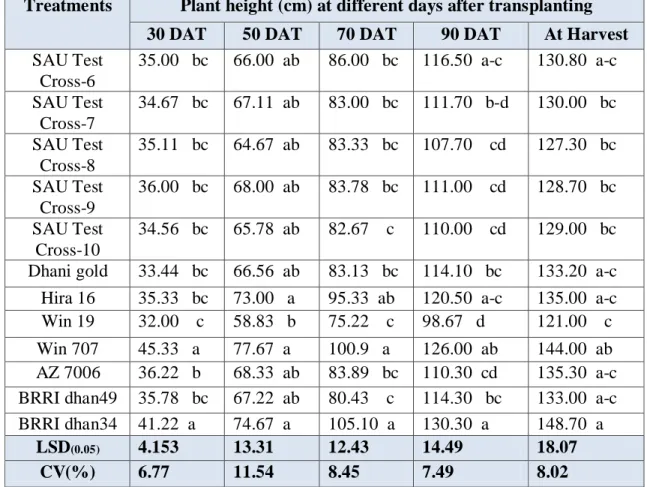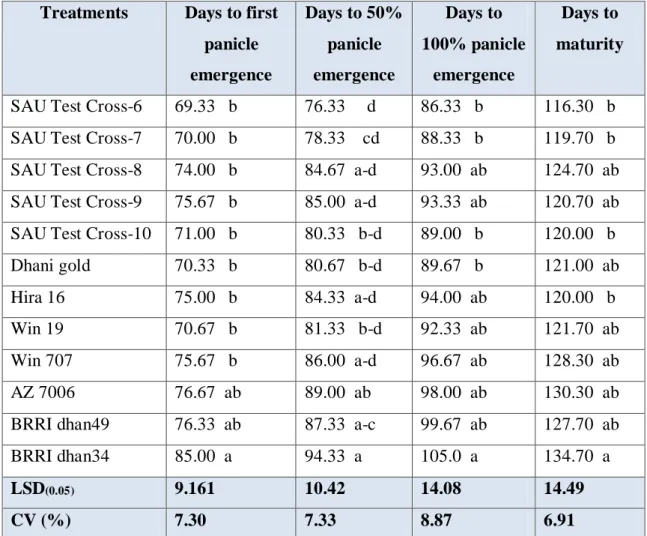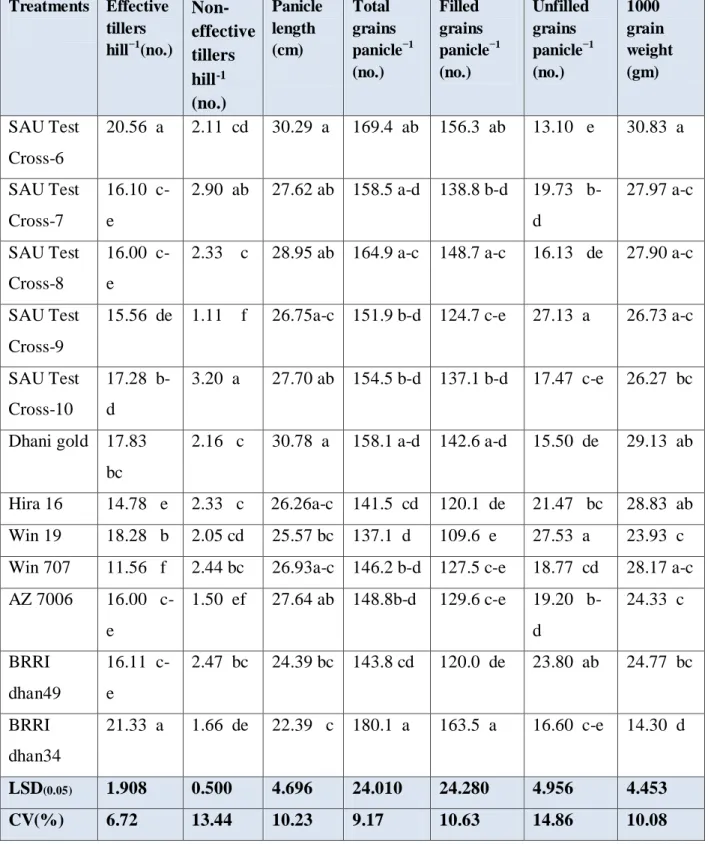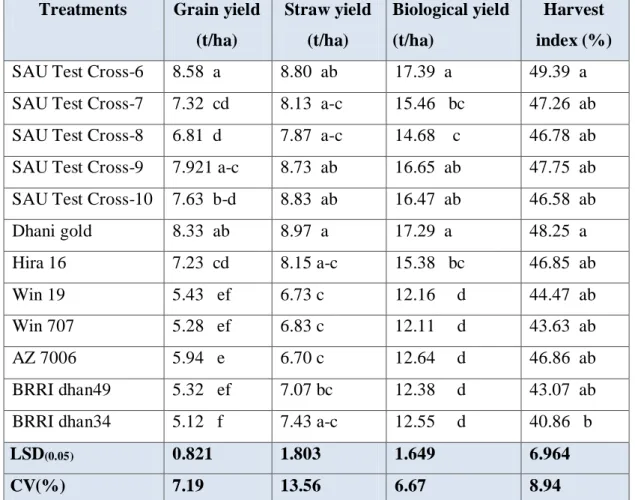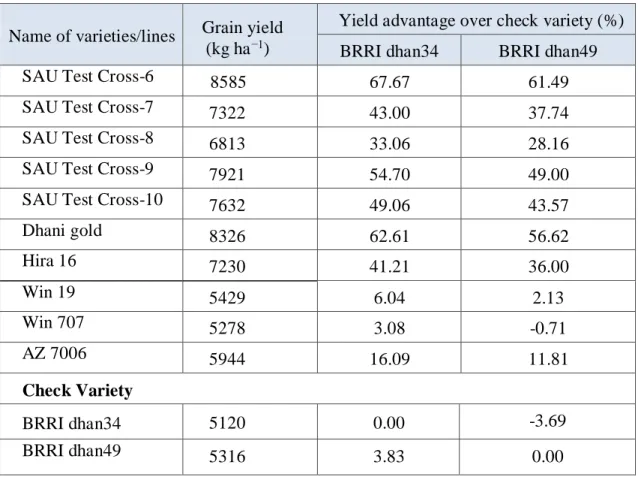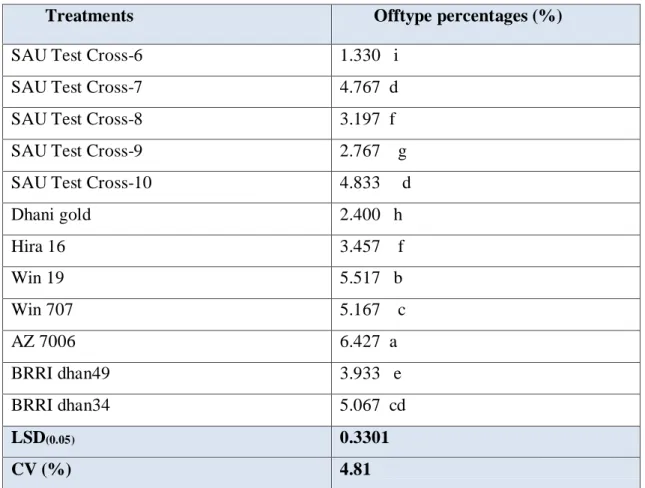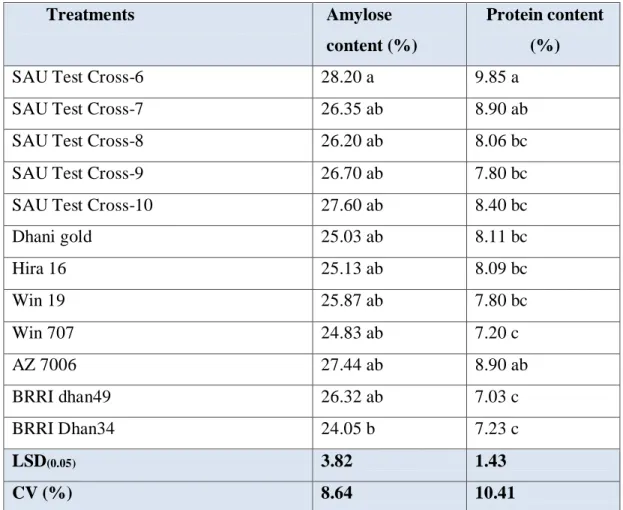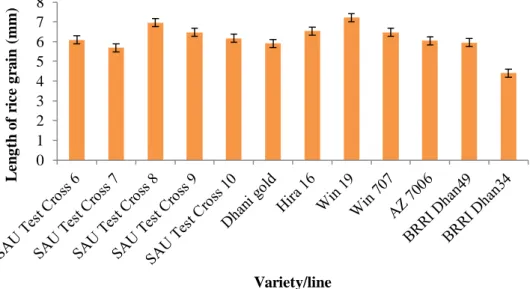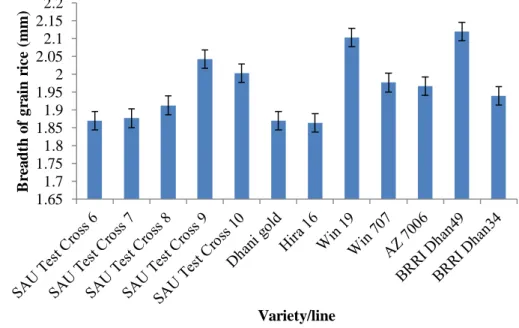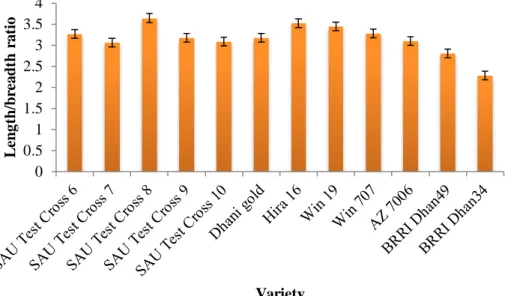EXPLORATION OF GENETICAL PURITY, YIELD PERFORMANCE AND GRAIN QUALITY OF SLENDER GRAIN HYBRID T. AMAN RICE
MD. MEHEDI HASAN SUMON
DEPARTMENT OF AGRONOMY
SHER-E-BANGLA AGRICULTURAL UNIVERSITY DHAKA-1207
JUNE, 2020
EXPLORATION OF GENETICAL PURITY, YIELD PERFORMANCE AND GRAIN QUALITY OF SLENDER GRAIN HYBRID T. AMAN RICE
By
MD. MEHEDI HASAN SUMON REGISTRATION NO. 13-05279
A Thesis
submitted to the Faculty of Agriculture
Sher-e-Bangla Agricultural University, Dhaka-1207 in partial fulfilment of the requirements
for the degree of
MASTER OF SCIENCE (MS) IN
AGRONOMY
SEMESTER: JANUARY- JUNE, 2020
APPROVED BY:
Prof. Dr. Md. Abdullahil Baque Supervisor
Prof. Dr. Md. Fazlul Karim Co-Supervisor
Prof. Dr. Md. Shahidul Islam Chairman
Examination Committee
DEDICATED TO MY
BELOVED PARENTS AND
RESPECTED SUPERVISORS
Chapter I
Introduction
1
CHAPTER I INTRODUCTION
Rice (Oryza sativa L.) belongs to the Poaceae family of cereal crops. After wheat in the world crops, rice ranked 2nd in the world crops. Bangladesh ranks 4th in both the rice region and production among the world are leading rice growing nations (BRRI, 2017). In Bangladesh, rice is the main food crop and around 11.35 million ha of the total arable land is used for rice cultivation (FAO, 2017).
In addition, Bangladesh is the 3rd largest country in the world based on the cultivation of rice (BBS, 2019). Rice is used as a staple food by almost half of the world’s population. In Asia, over 90% of the rice in the world is grown (BBS, 2013). Rice alone occupies about 77% of the total cultivated area among the 150 different crops grown in Bangladesh. In Bangladesh, the area and production of total rice is approximately 11.35 million hectares and 35.56 million metric tons (BRRI, 2017).
Annual per capita rice consumption in Bangladesh is the highest in the world (Nasiruddin, 1993). It accounts for 76% of the caloric intake and 66% of the protein intake (BNNC, 2008). Its share of agricultural GDP is approximately 70%, while its share of national revenue is one-sixth. It is, by far, the largest source of salary, business, reserve funds and interest in the economic sector. The population of Bangladesh continues to grow and will require about 47.26 million tons of rice for 2020 (BBS, 2016). But in Bangladesh, the average yield (2.98 t ha-1) of rice is poor (BRRI, 2017). On the other hand, due to high population pressure as well as climate change, the rice production area is decreasing day by day. Food security has been and will continue to be a major concern in Bangladesh, as food requirements are increasing at an alarming rate due to population growth. In any way, Bangladesh needs to further develop the yield of rice in order to meet the growing need. The main source of livelihood is rice cultivation and about 72% of the agricultural production comes from rice.
Therefore, the rice yield must be raised from the current 2.98 to 3.74 t ha-1 (BRRI, 2019).
2
Aus, Aman and Boro, there are three rice growing seasons that have appeared distinctly almost all over in Bangladesh. In the seasons of Aus, Aman and Boro, the total yield of rice was 2.92, 15.34 and 19.91 million metric tons, respectively (BBS, 2019). Thousands of local rice landraces exist in Bangladesh, many of which are either fine grain or aromatic types. Most of the aromatic rice varieties in Bangladesh are of a traditional type, sensitive to photoperiods and are grown during the Aman season in lowland rainfall (Das and Baqui, 2000). During the Aman season, 30 percent of the rice land in northern districts of Bangladesh was covered by aromatic rice cultivars (Islam et al., 2012). Aromatic rice plays a vital role in the international trade in rice. Bangladesh mainly exports Kalizira, a highly aromatic variety, as well as other varieties such as Kataribhog, Bansful and Chinigura. Bangladesh has a bright prospect for export of fine rice thereby earning foreign exchange (Islam et al., 2012).
The demand of aromatic rice in this country is increasing due to its special appeal for aroma and acceptability although grain yield is low. Aromatic rice is the most highly valued rice commodity in Bangladesh agricultural trade markets having small grain and pleasant aroma with soft texture upon cooking (Dutta et al., 2002). However, the price of fine rice, especially the aromatic rice is 2-3 times higher than that of coarse rice (Ashrafuzzaman et al., 2009). In spite of low yielding of aromatic rice, it requires less input compared to coarse rice. To achieve this goal, besides conventional breeding method, new strategies must be devised to elevate aromatic rice productivity to accommodate the growing demand. At the same time, with the application of almost the same amount of agricultural inputs, hybrid rice has a yielding advantage of approximately 15-20 percent over the best commercial rice cultivars (Babu et al., 2013). Higher hybrid rice grain yield is an intricate result that produces higher yields than modern cultivars and attracts the attention of farmers (Lin and Yuan, 1980). In 1974, Chinese scientists successfully transferred the interaction between the male genotype and the environment. Hybrid rice grows well in China and the wild rice sterility gene creates the cytoplasmic male-sterile genetic (CMS) line and hybrid combination (Chen et al., 2008). After China, Vietnam began to cultivate large-scale hybrid rice in 1992, followed by India, Bangladesh,
3
Myanmar and the Philippines (Julfiquar et al., 2006). Hybrid rice technology has proven to be one of the most feasible and readily acceptable approaches to breaking down the possibility for lower yields. Convinced of the potential of hybrid rice technology to enhance production, Bangladesh has adopted this technique and released almost a dozen hybrid rice varieties for further cultivation (Mamun et al., 2012). The yield increases in the hybrid varieties of lower percentages of offtype plants resulted higher genetic purity which resulted mainly in higher yield potential (Jiang et al., 1995). Therefore, emphasis should be placed on increasing rice yields through enhanced technology and management practices, as a potential replacement may be hybrid rice. Therefore, it is considered essential to look for an alternative way to boost production.
Proper practices are the most efficient means of increasing farmer-level rice yield that can be achieved by using inbred and hybrid varieties (BBS, 2005). By introducing a new approach to rice production through hybrid technology, scientists are quite optimistic about breaking the existing yield ceiling.
So, it is essentially required to know the impact of different hybrid rice varieties and also to determine their adaptability in prevailing environments of Bangladesh. Under the above circumstances, the present experiment was undertaken with the following objectives:
i. To explore the growth, yield and yield components and quality of hybrid genotype and check varieties grown in T. aman season.
ii. To evaluate candidate hybrid genotype with improved yield potential over inbred ones.
iii. To screen out the genetical purity of the hybrid genotype and the check varieties of rice and evaluating the best one.
Chapter II
Review of Literature
4
CHAPTER II
REVIEW OF LITERATURE
Due to the varietal execution of different rice cultivars and management practices, the growth and progress of rice is affected. Inbred and hybrid varieties could likewise be affected. Experimental findings are available from home and abroad to reveal that rice cultivars with high return potential can have an incredible degree of impact on growth and respect.
In this part, important audits on the above perspectives were displayed and discussed.
2.1 Relationship and differences of plant growth and development characteristics of hybrid and inbred rice varieties
As is evident from its overall distribution, rice has a broad flexibility to distinct environmental conditions. Various parameters, such as plant height, effective tillers hill-1, number of filled grain panicle-1 and number of unfilled grains panicle-1, 1000-grain weight, panicle length and harvest index as well as environmental factors control the yield of a rice cultivar.
Growth parameters such as plant height, effective tillers hill-1, etc. are also important to evaluate the possibility of yield. Some accessible data and writing identified with the characters of hybrid and inbred rice cultivars in plant development are cited below:
2.2 Morphological attributes 2.2.1 Effect of rice varieties
Rice is the staple food and in the highly populated region of South and Southeast Asia, about ninety percent of rice is grown and consumed.
Bangladesh produces hybrid rice varieties and, for regular consumption, most of them have excellent production and food quality. The impact of rice varieties on yield-contributing components and grain yield has been reported by various researchers. Some of the important and informative works and research results related to hybrid yield and quality, however, have been done at home and abroad so far, reviewed below-
5 2.2.2 Plant height (cm)
Masum et al. (2008) found that rice plant height was affected by varieties in the Aman season where Nizershail produced the higher plant height at different days after transplanting (DAT) than BRRI dhan44. Three varieties (cv. BRRI dhan28, BRRI dhan29 and Binadhan-14) and four water management systems were tested in an experiment to investigate the impact of the variety and water management system on boro rice growth, development and yield execution. The highest plant height, maximum number of tillers hill-1, dry matter of shoot hill-1 and dry matter of root hill-1 were obtained from BRRI dhan29 at 100 DAT and the lowest grades were observed in Binadhan-14. With the exception of 1000-grain weight, variety had a significant impact on all the crop attributes under test. The highest grain yield from BRRI dhan29 was found and from Binadhan-14 the lowest grain yield was recorded (Murshida et al., 2017).
An experiment was directed by Sarkar et al. (2014) to examine the yield and quality of aromatic fine rice as influenced by the management of variety and nutrients. Three aromatic fine rice varieties were included in the experiment: viz. BRRI dhan34, BRRI dhan37 and BRRI dhan38, respectively. In BRRI dhan34, the highest plant height (142.7 cm), the highest number of effective tillers hill-1 (10.02), grains panicle-1 (152.3), panicle length (22.71 cm), 1000-grain weight (15.55 g) and grain yield (3.71 t ha-1) were achieved.
Islam et al. (2009) was conducted a pot experiments to contrast the growth and yield behavior of hybrid and inbred rice varieties under controlled conditions with the hybrid variety Sonarbangla-1 and inbred modern varieties BRRI dhan31 and BRRI hybrid dhanl. BRRI dhan3l had about 10-15 percent higher plant height, very similar tillers plant-1, 15-25 percent higher leaf area compared to Sonarbangla-1 at all days after transplantation (DAT). At 25 DAT, Sonarbangla-1 resulted in about 40 % higher dry matter production but had very similar dry matter production
6
at 50 and 75 DAT, 4-11% higher rooting depth at all DATs, about 22%
higher dry root weight at 25 DAT, but 5-10% lower dry root weight at 50 and 75 DAT compared to BRRI dhan31. At 35 DAT (highest tillering phase), the photosynthetic rate was higher (20 μ mol m-2 sec-1) in BRRI dhan3l, but at 65 DAT, Sonarbangla-l showed a higher photosynthetic rate of 19.5 μ mol m-2 sec-1. BRRI dhan3l showed higher panicles plant-1 than Sonarbangla-1, but Sonarbangla-1 resulted in higher grains number panicle-1, 1000-grain weight and grain yield than BRRI dhan31. Anwar and Begum (2010 ) revealed that rice tiller separation time significantly affected plant height, total number of tillers hill-1, number of bearing tillers and panicle length, but there was no effect on grain and straw yields. Sonarbangla-1 therefore appeared to be tolerant of tiller separation, and without hampering grain yield, separation should be done between 20 to 40 DAT.
2.2.3 Number of tillers hill-1 (no.)
Bhuiyan et al. (2014) conducted an experiment to explore various avenues to determine the adaptability and implementation of different hybrid rice varieties and to recognize and prescribe to rice farmers the best hybrid rice varieties in terms of yield. The different hybrid rice varieties evaluated had significant effects on the number of tillers and the number of productive tillers, based on the results of the study. As a planting material among hybrid rice varieties, RGBU010A × SL8R is therefore recommended because it has produced more productive tillers. During the Aman season, an experiment was performed to study their effects on the yield and yield contributing characters of rice varieties BR23 and Pajam with 2, 4 and 6 seedlings hill-1. They disclosed that cv. in terms of yield and yield components, i.e. productive tillers number hill-1, panicle length, l000-grain weight, grain yield and straw yield, BR23 showed better performance over Pajam.
7
The cultivar Pajam, on the other hand, delivered significantly the highest plant height, number of total grains panicle-1, number of filled grains panicle-1 and number of unfilled grains panicle-1 (Kashem et al., 2005).
A field experiment was conducted by Khatun et al. (2018) to evaluate the growth, yield and yield characteristics of aromatic rice (cv. Tulshimala) under the fertilization of cow dung (organic manure) and zinc (micronutrient). From the results of the experiment, the application of different levels of cow dung and zinc fertilizers showed that the total number of tillers hill-1, productive number of tillers hill-1, panicle length, test weight ( g), grain yield hill-1 (g), straw yield hill-1 (g), grain yield (t ha-1), straw yield (t ha-1), and biological yields over control were significantly increased. However, the combination of CD1Zn2 i.e. 10 t ha-
1 cowdung and 12 kg ha-1 ZnSO4 together with other recommended inorganic fertilizer doses produced the highest yield of grain (2.79 t ha-1) and straw yield (5.80 t ha-1) over other treatments.
An experiment was directed by Islam et al. (2014) to examine the yield and quality of aromatic fine rice as influenced by the management of variety and nutrients. Three aromatic fine rice varieties were included in the experiment: viz. BRRI dhan34, BRRI dhan37 and BRRI dhan38, respectively. In BRRI dhan34, the highest plant height (142.7 cm), the highest number of effective tillers hill-1 (10.02), grains panicle-1 (152.3), panicle length (22.71 cm), 1000-grain weight (15.55 g) and grain yield (3.71 t ha-1) were achieved. Chowdhury et al. (1993) stated that the BR23 cultivar showed superior performance over Pajam in terms of characters contributing to yield and yield i. e. Number of productive tillers hill-1. 2.3 Phenological characters
2.3.1 Days to first panicle initiation
Parvez et al. (2003) observed that Sonarbangla-1 showed shorter field duration was observed in than the control. Ma et al. (2001) conducted a
8
comparative study to screen out the performance of 8 rice hybrids. All hybrids showed shorter growth duration (97–107 days) than the controls (110– 116 days). They also experimented with ADTRH1 which is a rice hybrid.
This hybrid produced first panicle initiation than the other variety. It observed that a semi-dwarf variety and reached maturity in 115 days.
Iftekharuddaula et al. (2001) reported that first panicle initiation, days to 50% panicle initiation, days to maturity, plant height and spikelets panicle−1 had positive and higher indirect effect on grain yield through grains panicle−1. Padmavathi et al. (1996) reported that days to first panicle initiation, 50% panicle initiation had higher positive direct effects on number of panicles plant−1 and panicle length. Days to 50% flowering, number of grains panicle−1 and plant height had positive direct effects on grain yield.
2.3.2 Days to 50% panicle initiation
Most scientists indicated that days to 50% panicle initiation has direct and indirect effect on yield, grains panicle−1 and also on plant height.
Vijayakumar et al. (1997) found that hybrids out yielded their parents when their days to 50% panicle initiation were similar or more than their respective restorers. Sathya et al. (1999) studied on eight quantitative traits in rice (Oryza sativa). Days to 50% panicle initiation was the principal character responsible for grain yield plant-1 followed by 1000- grain weight, plant height and harvest index as they had positive and significant association with yield. Iftekharuddaula et al. (2001) reported that days to first panicle initiation, days to 50% panicle initiation, days to maturity, plant height and spikelets panicle−1 had positive and higher indirect effect on grain yield through grains panicle−1. Roy et al. (1989) concluded that generally the plants which needed more days for 50%
panicle initiation gave more yield.
9 2.3.3 Days to 100% panicle initiation
Vijayakumar et al. (1997) found that hybrids out yielded their parents when their days to 100% panicle initiation were similar or more than their respective restorers. Padmavathi et al. (1996) suggested that days to 100%
panicle initiation had higher positive direct effects on number of panicles plant−1 and panicle length. Days to 100% panicle initiation, number of grains panicle−1 and plant height had positive direct effects on grain yield.
Sathya et al. (1999) studied on eight quantitative traits in rice (Oryza sativa). Days to 50% flowering was the principal character responsible for grain yield plant−1 followed by 1000-grain weight, plant height and harvest index as they had positive and significant association with yield.
2.3.4 Days to maturity
Swain et al. (2007) assessed an experiment and shown that among the medium-duration varieties (115–130 days), there was good agreement between simulated and observed leaf area index, biomass, and grain yield.
The simulated biomass of long-duration varieties (135–150 days) showed large deviation from observed biomass at flowering. In the wet season of 2000, the model precisely anticipated the grain yield, biomass and leaf area index of medium and long-duration varieties.
Patnaik and Mohanty (2006) showed that there was a wider variation in the maturity duration of varieties. The flowering duration was the longest in CR 874-23 (153 days) followed by CR 758-16 (151 days). The earliest variety found to be Swarna (110 days). Wei et al. (2004) experimented with Yueza 122 which was bred by crossing GD-1S with Guanghui 122.
They concluded that the hybrid showed wide adaptability, higher grain yield, moderate growth period and fine grain quality, high resistance to rice blast and medium resistance to bacterial blight.
Parvez et al. (2003) observed that Sonarbangla-1 showed shorter field duration was observed in than the control. Ma et al. (2001) conducted a
10
comparative study to screen out the performance of 8 rice hybrids. All hybrids showed shorter growth duration (97–107 days) than the controls (110– 116 days). They also experimented with ADTRH1 which is a rice hybrid. This hybrid was semi-dwarf and reached maturity in 115 days.
Wang (2000) experimented in plot trials in 1998 and 1999, where growth period of early hybrid rice cv. Zhe 9516 was 116 and 117 days, respectively. The morphological and physiological attributes of Yueza 122 were investigated by Huang et al. (1999).
The results showed that in the early cropping season it was an early mature hybrid combination with a duration of 83 days from sowing to heading.
Pruneddu and Spanu (2001) conducted an experiment and concluded that Ebro was the earliest hybrid rice cultivar, reaching maturity 114 days after sowing; whereas, Balilla, Tejo and Thaibonnet were the latest; reaching maturity 128 days after sowing.
2.4 Correlation and differentiation in yield contributing characters and yield of hybrid and inbred rice varieties
Variety itself is a genetic factor that contributes greatly to the production of better rice yield. The performance of rice varieties on grain yield was evaluated by different researchers. Some available information and literature are discussed here relating to the yield contributing characteristics and yield of hybrid and inbred rice cultivars.
Haque and Biswash (2014) conducted five hybrid rice varieties collected from various private seed organizations and one Bangladesh Rice Research Institute (BRRI) hybrid and two inspections. Sonarbangla-1, Jagoron, Hira, Aloron, Richer, BRRI hybrid dhan1 were the varieties and BRRI dhan28 and BRRI dhan29 were the two controls. The highest plant height in the experiment was 101.5 cm for BRRI dhan28 and the lowest plant height was 82.5 cm for Richer. BRRI dhan29 required maximum days (116.3 days) and BRRI dhan28 required fewer days (95 days) in the
11
event of 50 percent flowering. Hira showed the best performance in the number of effective tillers (17.7) and Sonarbangla-1 showed the lowest performance (13.3). Sonarbangla-1 required fewer days (118 days) and BRRI dhan29 needed the maximum days (148 days) to consider the days for development. Richer demonstrated the best performance (27.7 cm) in panicle length status, while BRRI dhan28 showed the least performance (26 cm). The number of filled grains panicle-1 was the most notable for BRRI dhan29 (163.3), though, Jagoron was only 118. The number of all out grains in BRRI dhan29 (201.7) was most noteworthy and for Jagoron it was only 133.7.
Then again, Aloron was the best hybrid for the 1000-grain weight. In the case of biological yield (g), the best return was shown by BRRI dhan29 (49.6 g) and only 18 g by Hira. Given the performance of the whole variety, the Aloron variety was the best variety in the study than the respective varieties.
Islam et al. ( 2010) considered yield capacity at the International Rice Research Institute (IRRI) farm under optimum crop management of 16 rice genotypes including 12 hybrids, 3 inbreds and 1 New Plant Type (NPT) to achieve the most extreme feasible yield during the wet season (WS) of 2004 and dry season (DS) of 2005. The yield and yield components at maturity have been determined. The most noteworthy grain yield (7.7 t ha-1) was provided by IR76712H, followed in WS by IR75217H and Magat (7.6 t ha-1). The most elevated grain yield (9.17 t ha−1) was achieved by IR79118H in DS, followed by IR73855H (8.9 t ha−1) and SL-8H (8.8 t ha−1). The higher yield was due to a higher harvest index (0.50) for hybrid rice. Hybrid generated higher panicle-1 and 1000- grain weight of spikelets than inbred rice. The percentage of inbred spikelet filling was higher than hybrid rice. The NPT genotype of rice had the least percentage of spikelet filling, yet the most noteworthy 1000- grain weight over the season.
Halder et al. (2018) conducted an experiment to determine the effect of
12
the variety and planting density on yield and yield contributing characteristics of local aromatic rice. The experiment was developed with three replications in a factorial randomized complete block design, consisting of three local aromatic rice varieties (Chinigura, Shakhorkhora and Kalizira) and four planting densities S1 (25 × 20 cm), S2 (20 × 20 cm), S3 (20 × 15 cm) and S4 (20 × 10 cm) respectively. The findings demonstrated that the local aromatic rice var. The most notable number of grain panicle-1 (131) and 1000-grain weight (13.8 g) grains were produced by the Shakhorkhora variety, resulting in higher grain (2.63 t ha-1), followed by Kalizira (2.56 t ha-1) and straw yield (4.21 t ha-1). On the other hand, the higher number of tillers hill-1 (14.8), the number of grains panicle-1 (140 nos.) were found with higher grain yield in 20 cm × 20 cm spacing.
Islam et al. (2009) conducted pot experiments during T. Aman season in net house at Bangladesh Rice Research Institute (BRRI). Hybrid variety Sonarbangla-1 and inbred modern variety BRRI dhan31 was used in both the seasons. BRRI dhan3l had higher panicles plant-1 than Sonarbangla- 1, but Sonarbangla-1 had higher number of grains panicle-1, 1000-grain weight.
An experiment to evaluate the effect of variety and nitrogen levels on the yield performance of fine aromatic rice was conducted by Paul et al.
(2014). The experiment consisted of three types, i.e. Kalizira, Binadhan- 13 and dhan34 BRRI, and six nitrogen levels, viz. USG 1.8 g 4 hills-1 (55 kg N ha-1) and USG 2.7 g 4 hills-1 (80 kg N ha-1). 0, 30, 60, 90 kg N ha-1 It was noted from the results that the yield of aromatic rice was significantly affected by variety, level of nitrogen and their interaction.
Binadhan-13 achieved the highest grain yield (3.33 t ha-1), followed by BRRI dhan34 (3.16 t ha-1), and Kalizira obtained the lowest grain yield (2.11 t ha-1).
13 2.5 Yield components and yield
2.5.1 Number of effective tillers hill−1 (no.)
Sarkar et al. (2014) assessed the yield and quality of aromatic fine rice as influenced by the management of variety and nutrients and showed that the variation in plant height, number of effective tillers hill-1 and number of grains panicle-1 among the varieties was likely due to inheritance or varietal characteristics. Hossain et al. (2008) reported that number of panicles was the result of the number of tillers produced and the proportion of effective tillers, which survived to produce panicle. Lee et al. (1992) reported that the quantity of spikelet panicle−1, panicle length and grain yield panicle−1 were higher in the primary tiller and diminished with expanding tiller order with delaying panicle emergence in rice.
Metwally et al. (2012) reported that in the two seasons, aromatic rice varieties differed significantly in panicle number m-2. The highest panicle number m-2 at harvest in the two seasons was noticeably produced by IR77510 variety. In the first and second seasons, IR 65610 and IR 71137 varieties produced the lowest panicle number of m-2, respectively.
The increase in the number of panicles m-2 may be due to the increase in the number of tillers m-2. Mahapatra and Padalia (1971) reported an increase in the production of effective tillers hill-1 with the increase in panicles which are responsible for higher yield.
2.5.2 Number of non-effective tillers hill−1 (no.)
Hossain et al. (2008) reported that number of panicles was the result of the number of tillers produced and the proportion of effective tillers, which survived to produce panicle. Metwally et al. (2012) reported that in the two seasons, aromatic rice varieties differed significantly in panicle number m-2. The highest panicle number m-2 at harvest in the two seasons was noticeably produced by IR77510 variety. In the first and second seasons, IR 65610 and IR 71137 varieties produced the lowest panicle number of m-2, respectively. The increase in the number of panicles m-2 may be due to the increase in the number of tillers m-2.
14 2.5.3 Total grains panicle−1 (no.)
An examination was directed by Sarkar et al. (2016) to evaluate the yield and nature of aromatic fine rice as influenced by variety and nutrient management during the period from June to December 2013. The test included three aromatic fine rice varieties viz. BRRI dhan34, BRRI dhan37 and BRRI dhan38, and eight nutrient management viz. control (no manures and fertilizers), suggested portion of inorganic fertilizers, cow- dung at 10 t ha-1, poultry manure at 5 t ha-1, 50% of suggested portion of inorganic fertilizers + 50% cow-dung, 50% of suggested portion of inorganic fertilizers + 50% poultry manure, 75% of suggested portion of inorganic fertilizers + 50% cow-dung and 75% of suggested portion of inorganic fertilizers + 50% poultry manure. The examination was laid out in a randomized complete block design with three replications. The tallest plant (142.7 cm), the most elevated number of effective tillers hill-1 (10.02), number of grains panicle-1 (152.3), panicle length (22.71cm), 1000-grain weight (15.55g) and grain yield (3.71 t ha-1) were recorded in BRRI dhan34.
The most elevated grain protein content (8.17%) was found in BRRI dhan34 though the most elevated fragrance was found in BRRI dhan37 and BRRI dhan38. The most noteworthy number of effective tillers hill-1 (11.59), number of grains panicle-1 (157.6), panicle length (24.31 cm) and grain yield (3.97 t ha-1) were recorded in the supplement the executives of 75% suggested portion of inorganic fertilizers + 50% cow-dung (5 t ha-
1). The treatment control (no manures and fertilizers) gave the lowest values for these attributes. The most elevated grain yield (4.18 t ha-1) was found in BRRI dhan34 combined with 75% suggested portion of inorganic fertilizers + 50% cow-dung, which was factually indistinguishable from BRRI dhan34 joined with 75% of suggested portion of inorganic manures + half poultry manure and the least grain yield (2.7 t ha-1) was found in BRRI dhan37 in charge (no manures and manures). The most elevated grain protein content (10.9 %) was acquired
15
in the association of BRRI dhan34 with suggested portion of inorganic fertilizers which was in the same class as that of BRRI dhan38 and 75%
of suggested portion of inorganic fertilizers + 50% poultry manure. The most noteworthy aroma was found in BRRI dhan38 combined with 75%
suggested portion of inorganic fertilizers + 50% cow-dung.
A study was conducted by Saha et al. (2015) to assess the degree of variability between small grain aromatic (SGA) rice (Oryza sativa L.) genotypes for yield and yield components. At the BRAC Agricultural Research and Development Centre, Gazipur, Bangladesh, twenty four popular SGA rice genotypes were assessed for yield and yield- contributing characters. As the control variety, BRRI dhan34 was used.
Chinikanai-1, which was followed by Kalijira PL-9, Kalijira PL3 and Badshabhog, experienced the highest grain yield per plant. Chinikanai-1 had the highest amount of grain per panicle. The correlation analysis revealed that the positive contribution to grain yield was the number of panicles per plant (r = 0.646) and the number of grains per panicle (r = 0.525). Based on a sensory test, 18 genotypes were found to be scented and six to be lightly scented. Following the assessment of yield components, four genotypes, namely Chinikanai-1, Kalijira PL-9, Kalijira PL-3 and Badshabhog, have been selected as outstanding genotypes which can be used as potential breeding materials for the subtropical environment of Bangladesh. Myung (2005) worked with four different panicle types of rice varieties and observed that the primary rachis branches (PRBs) panicle-1 and grains were more on Sindongjinbyeo and Iksan467 varieties, but secondary rachis branches (SRBs) were fewer than in Dongjin1 and Saegyehwa varieties. Ashvani et al. (1997) studied 22 genotypically different strains of hybrid rice to correspond yield contributing attributes. Number of effective tillers plant−1 demonstrated significant and positive relationship at genotypic and phenotypic levels with grain yield panicle−1, 1000-grain weight and biological yield plant−1.
16 2.5.4 Panicle length (cm)
Ramalingam et al. (1994) found that long-panicle varieties, higher number of filled grains panicle-1 and more primary rachis would be suitable for selection because these characters had a higher positive association and were correlated between themselves with grain yield.
Hoque et al. (2013) investigated the performance of aromatic varieties on the growth and yield of aromatic rice and found that there were statistically significant differences between the varieties with respect to panicle length. Akbar (2004) revealed that almost all the crop characters differed significantly in variety, seedling age and their combined effect.
BRRI dhan41 performed the best among the varieties in terms of the number of effective tillers hill-1, panicle length, total spikelet panicle-1 and grain number panicle-1. BRRI dhan41 also delivered the maximum grain and straw yields. Sonarbangla-1 positioned first in regard of total tillers hill-1 and 1000-grain weight but produced highest number of non- effective tillers hill-1 and sterile spikelet’s panicle-1. Grain, straw and biological yields were resulted highest in the combination of BRRI dhan41 with 15 day-old seedlings.
Idris and Matin (1990) found that the length of the panicle differed between the varieties and was greater in IR 20 than in any of the native and high yielding varieties. Behera (1998) reported that by increasing the number of spikelets per panicle and panicle length, respectively, increasing panicle length and plant height may have indirectly increased rice grain yield. An experiment was directed by Islam et al. (2014) to examine the yield and quality of aromatic fine rice as influenced by the management of variety and nutrients. Three aromatic fine rice varieties were included in the experiment: viz. BRRI dhan34, BRRI dhan37 and BRRI dhan38, respectively. In BRRI dhan34, the highest plant height (142.7 cm), the highest number of effective tillers hill-1 (10.02), grains panicle-1 (152.3), panicle length (22.71 cm), 1000-grain weight (15.55 g) and grain yield (3.71 t ha-1) were achieved.
17
2.5.5 Number of filled grains panicle−1 (no.)
An experiment with six varieties of rice genotypes Mangala, Madhu, J- 13, Sattari, CR 666-16 and Mukti were conducted by Murthy et al. (2004) and they observed that Mukti (5.268 t ha-1) out yielded the other genotypes and recorded the maximum number of filled grains and had lower spikelet sterility (25.85%) contrasted with the others.
An experiment was conducted to study their impacts on the yield and yield contributing characters of rice varieties BR23 and Pajam with 2, 4 and 6 seedlings hill-1 during the Aman season. They revealed that the cv. BR23 demonstrated better performance over Pajam in regard of yield and yield components i.e. productive tillers number hill-1, panicle length, l000-grain weight, grain yield and straw yield. On the other hand, the cultivar Pajam delivered significantly the highest plant height, number of total grains panicle-1, number of filled grains panicle-1 and number of unfilled grains panicle-1 (Kashem et al., 2005). Parvez et al. (2003) reported that yield advantage for the hybrid rice was mainly due to the proportion of filled grains panicle−1, heavier grain weight (35%) and increased harvest index values than the control (28%).
Shrirame and Mulley (2003) conducted an experiment on the variability and relationship of different biometric and morphological plant characteristics with grain yield. Grain yield was noticeably affected by the number of grains filled with panicle−1. Ganesan (2001) experimented with 48 hybrids of rice.
Filled grain panicle−1 (0.895) had the highest positive direct effect on yield plant−1 followed by number of tillers plant−1 (0.688), panicle length (0.167) and plant height (0.149). Roy et al. (2014) evaluated 12 indigenous varieties of Boro rice where the height of the plant and tillers hill-1 at different DAT varied significantly between the varieties until harvest. The tallest plant (123.80 cm) was recorded in Bapoy at the time of harvest and the shortest (81.13 cm) in GS. Maximum hill-1 tillers (46.00) were observed at Sylhety Boro and minimum tillers (19.80) at
18
Bere Ratna. With the exception of grain yield, biological yield and harvest index, all yield and yield contributing characteristics varied significantly at the 1 % level of significance. The maximum effective hill-1 tillers (43.87) were recorded in the Sylhety Boro variety, while the lowest effective hill-1 tillers (17.73) were produced by Bere ratna. The highest (110.57) and lowest (42.13) filled grains panicle-1 was observed in the Koijore and Sylhety Boro varieties, respectively. The weight of one thousand grains was the highest (26.35 g) in Kali Boro and the lowest (17.83 g) in GS 1. Grain did not differ significantly among the varieties but numerically the highest grain yield (5.01 t ha-1) was found in the variety Koijore and the lowest in GS one (3.17 t ha-1).
An experiment was conducted by Shiyam et al. (2014) to evaluate the performance of four Chinese hybrid rice varieties in which FARO 15 was comparatively superior to the hybrids in all assessed growth and yield components. With more productive tillers (11.0), higher spikelets plant-1 (166.0), higher filled grain panicle-1 (156.17), higher filled grains (92.17 percent), higher 100 grain weight of 2.63 g and higher paddy yield (5.021 t ha-1) than others, FARO 15 was taller (140 cm) than others. Xudao151 came close to FARO 15 with a grain yield of 2,987 t ha-1 despite the relative poor performance of the hybrids. Mahamud et al. (2013) showed that rice cultivars vary considerably in all growth patterns, such as plant height, number of tillers and dry matter weight of different plant parts, panicle length, filled grain, unfilled grain, grain filling percentage, 1000 grain weight, grain yield and straw yield.
2.5.6 Number of unfilled grains panicle−1 (no.)
Chowdhury et al. (1995) reported that the cultivar BR23 showed superior performance over Pajam in respect of yield and yield contributing characters i.e. number of productive tillers hill−1, length of panicle, 1000- grain weight, grain and straw yield. On the other hand, the cultivar Pajam produced significantly taller plant, higher number of total spikelets
19
panicle−1, grains panicle−1 and unfilled spikelets panicle−1. Paul and Sarmah (1997) reported that yield was negatively correlated with false grains/panicle days to maturity, plant height and filled grains/panicle.
BINA (1993) reported differences in number of sterile spikelets panicle-1 due to varietal differences.
In all growth characteristics, such as plant height, the number of tillers and dry matter weight, length of the panicle, filled grains, unfilled grains, 1000 grains weight, grain yield and straw yield were varied considerably due to varietal execution (Mahamud et al., 2013). Chowdhury et al.
(1993) reported that the variation in number of unfilled grains panicle-1 might be due to genetic characteristics of the varieties.
2.5.6 1000-grain weight (g)
Halder et al. (2018) conducted an experiment to find out the effect of variety and planting density on the yield and yield contributing characters of local aromatic rice. The experiment was laid out in a factorial randomized complete block design with three replications, which consisted of three local aromatic rice varieties (Chinigura, Shakhorkhora and Kalizira) and four planting densities were viz. S1 (25 cm × 20 cm), S2
(20 cm × 20 cm), S3 (20 cm × 15 cm) and S4 (20 cm × 10 cm). The results showed that the local aromatic rice var. Shakhorkhora variety produced the most noteworthy number of grains panicle-1 (131) and 1000-grain weight (13.8 g), consequently higher grain (2.63 t ha-1), followed by Kalizira (2.56 t ha-1) and straw yield (4.21 t ha-1). One the other hand, higher number of tillers hill-1 (14.8), number of grains panicle-1 (140 nos.) were found in 20 cm × 20 cm spacing with higher grain yield.
Islam et al. (2014) directed an experiment to examine the yield and quality of aromatic fine rice as influenced by variety and nutrient management.
The experiment contained three aromatic fine rice varieties viz. BRRI dhan34, BRRI dhan37 and BRRI dhan38.
20
The highest plant height (142.7 cm), the highest number of effective tillers hill-1 (10.02), grains number panicle-1 (152.3), panicle length (22.71cm), 1000-grain weight (15.55g) and grain yield (3.71 t ha-1) were achieved in BRRI dhan34. Mahamud et al. (2013) showed that rice cultivars differed significantly in all growth characters, such as plant height, tillers number and dry matter weight of different plant parts, panicle length, filled grain, unfilled grain, filled grain percentage, 1000 grain weight, grain yield and straw yield. Uddin et al. (2001) conducted an experiment to determine the yield of hybrid, inbreed and locally improved rice varieties and reported that the variety had a significant effect on all crop characteristics under study. Sonarbangla-1 ranked first in 1000-grain weight, followed by Alok 6201 and Habigonj.
Mante (2016) reported that the weight of 1000 grains was significantly impacted by land preparation, crop establishment and varieties tested, similar to filled grains. There was interaction between treatments, but the significant differences may have been due to the varieties genetic characteristics.
Srivastava and Tripathi (1998) conducted an experiment and showed that the increased efficient tillers m-2, fertile grains panicle-1, panicle weight and 1000-grain weight could be attributed to an increase in grain yield in local control compared with hybrid. By using 1 seedling hill-1, Wen and Yang (1991) found a higher 1000-grain weight than with 4 seedlings hill- Ashraf et al. (1999) reported that the genetic character least influenced by the environment is 1000-grain weight, an important yield-determining component. An experiment was conducted by Islam et al. (2009) and reported that BRRI dhan3l had a higher weight of 1000 grains than BRRI dhan31 in 2001. Sonarbangla 1 had the highest 1000grain weight in 2002, followed by BRRI dhan31.
21 2.6.1 Grain yield (t ha-1)
Twenty-one advanced cultivars were examined in transplanted condition during 2005 wet season in a replicated trial along with three checks (Swarna, Pooja and Gayatri) for yield and yield contributing attributes like plant height, days to flowering and number of ear bearing tillers.
Variety Swarna (4.864 t ha−1) and CR 874-59 (4.675 t ha−1) shown higher grain yield compared with others. (Patnaik and Mohanty, 2006).
Talukdar et al. (2004) was carried out a field experiment at RDRS Bangladesh farm, Monthana, Rangpur, Bangladesh during July to December 2016 to evaluate the yield performance of seven aromatic rice varieties of Bangladesh viz. Jirakatari, Chiniatab, Chinigura, Kataribhog, Kalizara, Badshabhog and BRRI dhan34. Results from the study showed that, the entire yield contributing characters and quality parameters varied significantly among the aromatic rice varieties. The longest plant height (167.0 cm) was observed in the variety Chinigura and the shortest (120.1 cm) in the variety Chiniatab. In the variety, Kataribhog filled grains number panicle-1 was discovered most elevated (255.6) and the least (130.7) was recorded in the variety Badshabhog. Badshabhog delivered the most elevated 1000-grain weight (18.3 g) and the least (11.4 g) was recorded from the variety Kataribhog. The most elevated grain yield (2.54 t ha-1) was acquired from Kataribhog and the least grain yield (1.83 t ha-
1) was gotten from Kalizara. Among the seven aromatic rice varieties under North-west condition Kataribhog and BRRI dhan34 are reasonable in regard of yield.
Hassan et al. (2003) observed that grain yield is a capacity of interaction of various yield components such as number of productive tillers plant−1, spikelets panicle−1 and 1000-grain weight. Shrirame and Mulley (2003) revealed that grain yield shown a very strong positive correlation with harvest index. Grain yield was also significantly correlated with dry matter weight hill−1, effective tillers hill−1 and no. of filled grains panicle−1. Islam et al. (2015) was carried out an experiment was done by
22
at Mymensingh, Bangladesh with four fragrant fine rice viz. 'Chinisagar', 'Chiniatab', 'Basmati' and 'Awnless Minicat' with three distinctive date of relocating 20 January, 5 February and 20 February. Among the fragrant fine rice 'awnless Minicat' gave the best return (3.10 t ha-1) yet that was at standard with those of Basmati (1.77 t ha-1). Bhuiyan et al. (2014) conducted an experiment to observe and recommend to rice farmers the adaptability and performance of various hybrid rice varieties and to find the best hybrid rice variety in terms of yield and yield components.
The various hybrid rice varieties evaluated had significant effects on yield, based on the findings of the study. Therefore, RGBU010A SL8R is recommended among hybrid rice varieties as a planting material because it has produced favorable yields. Srinivasulu et al. (1999) reported that planting 1 seedling hill−1 in case of rice gave higher grain yield comparable to that of 2 seedlings hill−1.
Julfiquar et al. (1998) reported that six hybrids produced the control varieties in the International Rice Hybrid Observational Nursery (IRHON-96), of which three hybrids-IR6229A / IR29723-143-3-2-1R, IR58025A / IR34683-179-1-2-1R and IR58025A / IR21-567-18-3R gave 1 ton more yield than the same duration control variety. Six hybrids were researched for grain characters by Geetha et al. (1994). The highest yield (19.7 g plant−1) was ADRH4. In this hybrid, the increased yield was due to higher grain number plan-1. Correlation analysis showed that only grains plant-1 had a strong positive association with grain yield. Eleven hybrid cultivars were evaluated by Leenakumari et al. (1993) against four standard control varieties: Jaya, Rasi, IR20 and Margala.
They concluded that the highest yield was 7.9 t ha-1 from the hybrid cultivar OR 1002, followed by the hybrid cultivar OR 1001 (6.2 t ha-1).
Jaya gave the highest yield (8.4 t ha−1) among the control varieties.
Suprihatno and Sutaryo (1992) assessed the performance of seven IRRI hybrids and 13 Indonesian hybrids using IR64 and Way-Seputih as control varieties. They found that the control varieties were highly
23
yielding than the hybrids, the highest yield was IR64, considerably yielding IR6461H, IR64610H and IR62829A / IR54, which Way-Seputih in turn yielded.
2.6.2 Straw yield (t ha-1)
Halder et al. (2018) conducted an experiment to find out the effect of variety and planting density on the yield and yield contributing characters of local aromatic rice. The experiment was laid out in a factorial randomized complete block design with three replications, which consisted of three local aromatic rice varieties (Chinigura, Shakhorkhora and Kalizira) and four planting densities were viz. S1 (25 cm × 20 cm), S2
(20 cm × 20 cm), S3 (20 cm × 15 cm) and S4 (20 cm × 10 cm). The results showed that the local aromatic rice var. Shakhorkhora variety produced the most noteworthy number of grains panicle-1 (131) and 1000-grain weight (13.8 g), consequently higher grain (2.63 t ha-1), followed by Kalizira (2.56 t ha-1) and straw yield (4.21 t ha-1). One the other hand, higher number of tillers hill-1 (14.8), number of grains panicle-1 (140 nos.) were found in 20 cm × 20 cm spacing with higher grain yield.
Summers et al. (2003) conducted an experiment at multiple sites for the 1999 and 2000 seasons with eight common California rice cultivars and found variability in the quantity and quality of straw that can have critical effects on biomass industries. The highly recommended attribute for the straw yield was the length of the pre-heading period. Cutting height with a non-linear distribution, resulting in almost half of the straw biomass occurring in the lower third of the plant, also strongly affects the harvested straw yield.
The interaction between grain yield with the morphological parameters of five local and three modern aromatic rice varieties was investigated by Hossain et al. (2005). The highest straw yield was achieved by Kataribhog (8.9 t ha-1) and the lowest straw yield was similarly obtained from
24
Kalizera, followed by BRRI dhan37 and BRRI dhan38. Metwally et al.
(2012) reported that aromatic rice varieties exerted a significant effect on straw yield in the two seasons. Plants of Egyptian Yasmin and IR77510 in markedly produced the highest straw yield in the two seasons. Plants of IR65610 variety produced the lowest straw yield in the two seasons.
The superiority of Egyptian Yasmin and IR 77510 variety might have resulted from its better growth.
2.6.3 Biological yield (t ha-1)
Islam et al. (2013) observed that the highest biological yield (9.46 t ha-1) was obtained from the variety Kachra and the lowest biological yield (3.87 t ha-1) was recorded from the variety Kalijira. From the result, it was observed that biological yield differed due to combined effect of grain yield and straw yield. Plotting grain yield against biological yield 30 gave a significant positive linear relationship which indicates that as biological yield increased, grain yield also increased.
A field experiment was conducted by Khatun et al. (2018) to evaluate the growth, yield and yield characters of aromatic rice (cv. Tulshimala) under the fertilization of cow dung (organic manure) and zinc (micronutrient).
From the results of the experimentation showed that, the application of different levels of cow dung and zinc fertilizers considerably increased the total tillers number hill-1, productive tillers number hill-1, length of panicle, test weight (g), grain yield hill-1 (g), straw yield hill-1 (g), grain yield (t ha-1), straw yield (t ha-1), and biological yields over control.
However, the treatment combination of CD1Zn2 i.e. 10 t ha-1 cowdung and 12 kg ha-1 ZnSO4 along with other recommended doses of inorganic fertilizers produced the highest grain yield (2.79 t ha-1) and straw yield (5.80 t ha-1) over other treatments.
Peng et al. (2000) concluded that the increasing trend in cultivar yield due to the improvement in the harvest index (HI) was associated with yield trends for cultivar lines, while the increase in total biomass. Ramesha et
25
al. (1998) found that increased total biomass and increased panicle weight, with almost the same level of harvest index, resulted in the superior yielding capacity of the hybrids over the controls.
Kim and Rutger (1988) reported that greater biomass was also produced by hybrids that gave greater grain yields. Furthermore, for hybrid rice and conventional rice, biomass yield at different growth stages showed different patterns. In the early and middle growth stages, hybrid rice has more dry matter accumulation.
2.6.4 Harvest index (%)
Senapati and Sarker (2004) observed the adaptability of aman paddy under the sundarban regions of West Bengal. In 40 aman rice genotypes cultivated during the Kharif seasons of 1997, 1998, 1999 and 2000 under rainfed lowland conditions of Kakdwip, West Bengal, India, grain yield and number of days to maturity were evaluated. For both traits, they found distinct genetic variation and genotype-environment interaction. Twenty- one genotypes were found to be stable for several days until maturity. Of these, the late matured varieties CR-626-26-2-3, CR-383-10, Dudhraj, Lilabati, Dhusari and Bogamanohar were desirable for the cultivation of aman rice in the Sundarban regions. For grain yield, twenty-two genotypes were highly stable and widely adapted to the Sundarban areas.
Shrirame and Mulley (2003) experimented with variability and relationship studies of different biometric and morphological plant characteristics of rice with grain yield. It was conducted with the TNRH10, TNRH13 and TNRH18 rice hybrids and the Jaya cultivar. They found that the grain yield showed a very positive and significant correlation with the harvest index. Grain yield has also been significantly correlated with dry matter weight hill-1, efficient tillers hill-1 and number of filled grains panicle-1. In an experiment, Kiniry et al. (2001) stated distinct parameters describing crop growth and yield production
26
processes. In each of the 2 years, the mean harvest index was 0.32 (32 percent) for all four cultivars over the two harvests. They concluded that variations in yield among cultivars were due to differences in the harvest index.
Peng et al. (2000) concluded that the increasing trend in yield of cultivars released before 1980 was mainly due to the improvement in harvest index (HI), while an increase in total biomass was correlated to increasing yield trends for cultivars–lines developed after 1980. Cui et al. (1998) conducted a varietal trial of Japanese rice varieties (J group) along with 20 high yielding Asian rice varieties (H group).
They reported significantly higher yield and harvest index in H group than that of the J group. Days to heading (DTH) showed significantly positive correlation with total dry matter weight and a significantly negative correlation with harvest index.
Sitaramaiah et al. (1998) assessed six promising rice hybrids with two control varieties and found that MTUHR 2033, MTUHR 2020 and MTUHR 2037 hybrids gave higher grain yield, higher production of biomass and harvest index than other varieties. Higher yielding hybrids were also recorded for higher biomass yield and harvest index, they also showed. Hybrids were found to have a superior performance due to more panicle grains-1, which was indicated by a higher harvest index.
Jiang et al. (1995) assessed 10 varieties for yield components. The increase in yield of dwarf over high varieties was mainly due to higher harvest index, while the increase in yield of hybrid rice over dwarf varieties was mainly due to higher production of biomass. Hoque et al.
(2013) stated that harvest index is a vital character having physiological importance. They found that BRRI dhan50 produced the highest harvest index (0.44%) which was followed by Kataribhogh (0.34%). The lowest harvest index was found in Chandramukhi and Chinigura (0.30 %).
27
2.7 Yield advantage of fine hybrid varieties
A comparative study to assess four imported hybrid rice cultivars with a high yielding variety (BRRI Dhan29) was evaluated by Parvez et al.
(2003). The Chinese Sonarbangla-1 cultivar showed the best performance in terms of all the parameters under consideration. The other three Indian cultivars had lower performance than the control (Amarsiri-1, Aalok and Loknath). Sonarbangla-1 produced a 20% higher grain yield than the control (6.26 t ha-1) (7.55 t ha-1). The hybrid rice yield benefit was mainly due to the heavier grain weight (35 percent).
Ma et al. (2001) tested the comparative performance of 8 rice hybrids and the PS02 and PTT1 control cultivars.
As well as higher yields, the hybrids had more leaves (12-15.9) than the local cultivars (15.1-15.3). The highest yield (7,142 t ha−1) was produced by NN49, which was 58.78 percent and 26.52 percent higher than PS02 and PTT1. They have also been experimenting with ADTRH1, a rice hybrid. ADTRH1 showed a 26.9 percent and 24.5 percent higher yield over CORH1 and ASD18 respectively in various field studies, with an average yield of 6.6 t ha-1.
BAU (1998) conducted a field experiment at boro season, it was observed that hybrid rice Alok 6201 out-yielded the modern variety Iratom 24 by 29.48%. The higher numbers of tillers hill−1, effective tillers hill−1, spikelets panicle−1 and panicle length was found from Alok 6201;
whereas, Iratom 24 was found better in terms of 1000-grain weight only.
An experiment with 24 trial hybrid rice varieties was conducted by Widyastuti et al. (2015).
The outcomes demonstrated that grains yields were influenced by areas, seasons, and genotypes. The genotypes × areas × seasons cooperation impact was significant; along these, the best hybrid was different for each area and season. A7/PK36 hybrid has the best execution in Batang during the dry season, while A7/PK40 and A7/PK32 are the best hybrids in the
28
rainy season. In Sukamandi, 9 hybrids were recognized as better yielder over that of the check variety in the dry season, but not so in the rainy season. Ramana et al. (1998) was carried out an experiment and observed that the mean grain yield of the best performing rice hybrids was 37.7%
higher than the conventional cv. IR-64 during 1993; while in 1995, the maximum yield of rice hybrid MTUHR 2037 was 10.3%, 17.4% and 31.1% higher than that of comparing cultivars Chaitanya, BPT 5204 and Tellahamsa, respectively. The mean grain yield of rice hybrids during 1996 was 23.7% and 26% higher than BPT 5204 and Tellahamsa, respectively.
In an experiment with hybrid rice cultivars IR62829A / IR46R and MH841-1A / MR 167, Guok et al. (1997) found that the two hybrid rice lines, IR62829A / IR46R and MH841-1A / MR 167, had a yield advantage of approximately 24% to 26% over the best local control in 1995-96. Khush and Aquino (1994) in an experiment reported that the yield capability of modern high yielding varieties grown under the best tropical conditions is 9–10 t ha−1.Tropical rice hybrids under similar condition have shown yield potential about 12 t ha−1.
2.8 Evaluation of genetical purity 2.8.1 Offtype plants (%)
Among those varieties, Jiang et al. (1995) compared 10 varieties for yield components and offtype plant percentages. The yield increases in the varieties of lower percentages of offtype plants resulted mainly in higher yield potential. Hossain et al. (2005) examined the association between grain yield with the percentages of five local and three modern aromatic rice varieties of offtype plants. With the lowest percentage of offtype plants, Kataribhog produced the highest grain yield (3.2 t ha-1) than the BRRI dhan38.
29 2.9 Quality contributing characters 2.9.1 Amylose content (%)
As the main parameter of cooking and eating quality, the amylose content of rice is considered (Juliano, 1972). It is preferred to have intermediate to high amylose rice with a low to intermediate gelatinization temperature. Dahiphale et al. (2004) worked at Akola, found that quality parameters viz. kernel length (cm), kernel breadth (cm), kernel L/B ratio, kernel length after cooking, elongation ratio and amylose content (%) were not influenced significantly among Basmati genotypes.
Many of the cooking and eating characteristics of milled rice are influenced by the ratio of two kinds of starch, amylose and amylopectin in rice grain. The amylose content of nonwaxy rice ranges from 7 to 34%
of the milled rice on dry weight basis or 8 to 37% of the starch itself, glutinous or waxy varieties contain virtually no amylose. Most people in Bangladesh prefer high-amylose containing rice. In the majority of tropical Asia, including Bangladesh, high amylose rice is preferred. The content of amylose influences the properties of cooked rice, if the quantity is low, sticky. The content of amylose influences volume expansion, water absorption, cooked rice tenderness and stickiness. The amylose content in rice is used as the single most significant feature in the description and prediction of the quality of rice cooking (Kaul et al., 1982).
In the non-glutinnous varieties, amylose is the linear fraction of starch, while amylopectin, the branched fraction, makes up the rest of the starch.
The content of amylose correlates negatively with the taste panel scores for boiled rice cohesiveness, tenderness, color and gloss. In waxy (glutinous) rice, amylose is almost absent. Suchrice does not expand in volume, is glossy and sticky when cooked, and stays firm. In northern and north-eastern Thailand and Lao PDR, this rice is the staple food of individuals. A large majority of the rice has high amylose content from Vietnam, Thailand, Myanmar and the Indian subcontinent.
30
The ratio of the amylose and amylopectin in the rice grain influence the cooking and eating characteristics of rice. A high degree of flakiness is shown in this rice. It cooks dry, is less tender and, when cooled, becomes hard. Wet and sticky, low-amylose rice is cooked. All Japanese varieties from temperate regions have a low content of amylose. Varieties grown in the Philippines, Malaysia and Indonesia have intermediate amylose content and are moist and tender to cook and are not difficult to cool. With the increase of harvesting time amylose, carbohydrate and protein content are increased: they also concluded that expansion volume is also affected by the change of amylose content (Marzempi and Edi, 1990). Islam and Virmani (1990) observed that all the hybrids showed high amylose content than the parents.
2.9.2 Protein content (%)
In most developing countries, the source of protein for human consumption is cereals and pulses. Since rice is the staple food for Asians, the need to improve the amount of protein in rice is of paramount importance as a major item in their diet. One of the principal sources of protein for human beings is milled rice protein. The potential for quantitative and quantitative improvements in rice proteins appears to be considerable (Satoh et al., 1990).
Kader et al. (2018) found that BRRI dhan70 is another aromatic, high yielding and extra-long fine grain containing transplanted Aman rice variety that is an enhancement over BRRI dhan37, existing premium quality rice. In the proposed preliminary variety directed at the farmer's field, BRRI dhan70 was pleasantly gone. This assortment for business development in the wet season (T. Aman) of Bangladesh in 2015 was therefore affirmed by the National Seed Board (NSB). The straw shaded extra-long thin, higher lengthening capacity and odor of the cooked rice is the important element of BRRI dhan70. The length of development of BRRI dhan70 is 130 days, which is 10-15 days earlier than that of BRRI dhan37.
31
The assortment's one thousand grain weight is 20 g and it has a hued grain tip and a pointed awn. At 9.5% protein content, the rice has 21.7%
amylose content. Dwelling resilience is the exceptional character of the assortment. It has long, erect dark green banner leaf. BRRI dhan70 can create 4.8-5.0 ha-1 yield with legitimate administration which is around 1.0-1.35 tha-1 higher yield than BRRI dhan37. The exportable aromatic rice BRRI dhan70 is a brilliant assortment for developing in the wet (T.
Aman) season and ranchers can be profited by the development of BRRI dhan70.
Marzempi and Edi (1990) found that the amylose, carbohydrate and protein content increased with the increase in harvesting time. Rice is mainly the major source of calories, but to some extent it supplements protein.
2.9.3 Length of grain rice (mm)
Kishine et al. (2008) reported that rice grain quality largely depends on the physicochemical properties which are greatly influenced by the genotype. Size and shape (Length, breadth and L/B) are considered to be the first important criteria for the development of new variety for commercial production.
Dahiphale et al. (2004) w
